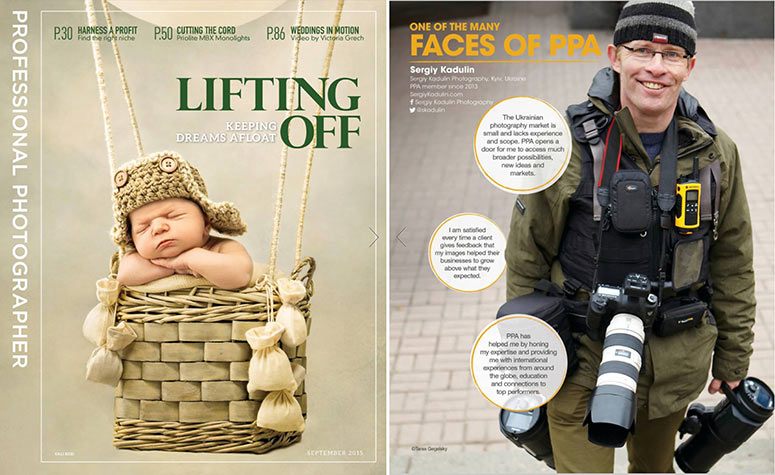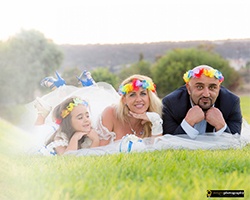Student Success: Student Success: Sergiy Kadulin

1. When did you realize that photography was the field you wanted to pursue?
Photography has been my passion and hobby since my childhood, when my grandfather taught my on the basics of film photography. But it remained my hobby, kind of ‘playing with the camera in spare time’ toy, but with growing interest to becoming professional, and up until 2013 when I decided to give up my 20-years corporate career and started own professional photography business.
2. When did you enroll at NYIP?
My desire to step into professional photography business was growing since 2006-2007. I understood that good preparation is needed to enter this exciting new field. I started to read lots of books on the matter, ordering them from Amazon, finding online resources, etc. In 2010 I took professional photography classes in the Kyiv School of Photography, where I got basics of profession. However, during my study, I realized that local photography schools in Ukraine lack knowledge, scope and experience of their counterparts in matured markets. For example, no school in Kyiv offered basics of business, sales and marketing for pro photographers, which I consider to be key component of the educational program and crone of successful photography business. Also, as I was full-time employee at that time, I was looking for convenient online-based study program, which I could take at my own pace. As a result, I enrolled in NYIP study in 2010, and it took me 1.5 years to complete required courses. My recognition diploma arrived in Ukraine exactly on my birthday, in January 2013. Five months later I started the business of Sergiy Kadulin Photography.
3. What was your coursework like?
I chose the professional photography course at NYIP as the most complete and best fit for my needs. To make sure that I did right investment, I purchased initially 2 or 3 units (NYIP offers money back guarantee for those who hesitate). After looking into them and starting my study process I purchased the complete course, all remaining units at once and got an extra discount.
I loved the study process! I was reading units’ materials in the mornings, waking up at 5 am, and in the evenings, after coming back from my office work, and every day I was waiting for these ‘happy hours’. Each unit came with the assignment related to the topic, and while not all units were in my sphere of interests, it was extremely useful to try different areas of the profession. I also liked the requirement of the school to send assignments as printed photographs, not just digital images. I consider printing mastery being one of key competitive advantages for pro photographers, the one which is not easy to obtain for amateurs and the one, which might be a good source of additional income.
4. Was your mentor helpful during the process?.
Absolutely. Each assignment submission was followed by online digital feedback (sent as a link to MP3 voice recording), it was great to receive it fast and listen at home. All comments were useful and interesting, very relevant to my mistakes and growth opportunities.
5. What type of work are you doing now?
Currently I am focused on two major areas. First is B2B professional services in architectural, interior, industrial and construction photography, where I serve clients from Ukraine and abroad. Second part is fine art photography, mostly personal artistic works, which I sell from my own stock as large format prints for interior decoration – for residential homes, offices, etc. I have two web sites for my business: this one is focused on architectural and interior photography and this one (which I created just recently) is devoted to my fine art prints. I use Photoshelter and Zenfolio platforms for these sites.
6. Tell us about Sergiy Kadulin Photography!
This is my love, my passion, my dream coming in reality. I can’t even name it ‘work’, because I consider it as love, or as light – materialized via my energy, variety of colors of photography profession, the way I express my inner self and open it up to the world. Somehow magically Sergiy Kadulin Photography unites everything I have been doing during my life: my love to arts (I was studying in the art school and was a painter for several years), my love to optics (my mother was optics engineer, and I was learning it also at school, where we started first holography section in Kyiv), then electronics, which I studied at the aviation military academy, continued with experience in IT, sales, business development and marketing, which I received during my 20-years career with major multinational companies such as APC, hp, Microsoft and Apple. Starting since 2013, when I started Sergiy Kadulin Photography from ground zero, I am one-man-running-show, but growing business and new opportunities make me thinking about expanding in the near future.
At the beginning it took me almost six months to conduct market research and make final decision about which areas I want to specialize in. Then it took about 1+ year to establish myself in the field: finding first clients, creating portfolio, building web site, establish all processes, etc. And it took another 1+ year to get to breakthrough and reach point of profitability.
When I was switching from great career in IT (with the salary of 6 figures) to photography, all my friends were telling me that I am crazy and that it is impossible to make money in photography in Ukraine. Despite of their pessimism, I was sure that with the dream, energy, proper preparation and actions - everything is possible, and my experience has shown that I was right. Currently I grew up from unknown name in the market to growing profitable business, with super-exciting new projects coming to me weekly and lots of open opportunities around.
7. How do you find new clients and advertise the work you do?
I found my first clients via LinkedIn. I still use its network power and my growing contacts base to reach out to new companies and opportunities. Second, I am using power of other social networks, such as Facebook, Instagram, etc. I took online course at Social Media Marketing University (SMMU) in 2009, which gave my good understanding of strategic approach towards online strategy, and I utilize this knowledge in my business. Definitely, word of mouth and recommendations from my clients are very strong engine of growth, but I also complement it with various online and offline activities – advertising, e-mail, trade shows, exhibitions, professional events like conferences, seminars, etc. I have also registered on major online resources, both local and international, and some clients find me through them.
8. What qualities do you think a successful, aspiring photographer needs?
First, and by far the most important is ‘mind of success’. The way of thinking which emanates energies leading to growth, expanding horizons, new discoveries.
Second – strong will to be at the top of the field in everything you do, supported by the actions: constant professional development and learning, taking new challenges, analyzing mistakes, improving own skills, etc.
Third – sharing and contributing to the world. Essential part of success, law of the universe. You can’t get anything until you first give it out. It also directly relates to the customer relationship: taking care of them, helping them, giving them great products, created with your love, will always return in the way of profitable business and new opportunities.
Four – being creative, finding blue ocean, finding new niches, developing in new areas.
9. What do you always carry with you in your camera bag?
- Backup camera, batteries and lenses, as they ensure that I will always perform my photoshoot.
- Professional tools which improve quality of my work compared to amateurs, such as Datacolor matrix, light cube and Seconic flash meter, filters, lights, etc.
- GPS unit, as I never know where my next assignment will be, and it is very convenient to have GPS data in the EXIF in my photographs.
- iPad – on the best photographers’ tool and assistant.
10. What’s the most interesting thing you learned at NYIP?
“Starting your own business” and all the books from ‘Essential business skills’ series were mostly interesting and useful for me. They were of great help when I started my own business. As I mentioned before, nothing similar existed in Ukraine, which made NYIP program of special value.
11. If you had to pick one, what was the most memorable photography project you’ve ever completed?
In 2016 I was hired to shoot a very special project. I needed to create a gigapixel photograph of the painting (9 x 12 meters size) on the curtain of Lviv Opera House. This painting called “Parnas”, is unique, as only three works of such scale, created by H. Siemiradzki, exist in the world: one in Ukraine, second in Krakow Opera House, Poland and third in La Scala, Italy.
“Parnas”, created in 1896-1900, also has very special and interesting history, making it one of treasures of the art in Ukraine. The original is so valuable, that usually people do not see it. It is being exposed to public only on special occasions, such as large premiers or special celebrations. And I was lucky to see and shoot it!
The requirement from the customer was to get as much detailed photograph as possible. It must show all tiny details of the painting and canvas, as well as provide absolute correct color reproduction. It was challenging to make: because of size, physical restrictions inside the main hall, poor lighting in the theatre, impossibility to use additional lights, time pressure, etc.
Finally, I created a unique panoramic image successfully, and the customer was absolutely happy about it. I wrote about experience in my blog (sorry, text is in Russian).
12. Describe a workday in your life as a photographer.
It is very different day from day. I might be shooting interior or architecture for one of my customers, or I might be shooting abstract photographs for my own stock collection of fine art images in some strange locations, or I might be at home developing images, working with the web sites, or creating blog post, and other marketing pieces. But regardless of activities each day has few common parts in it: (1) I start it early, about 5 am; (2) I start it with positive thinking exercise, and planning day and (3) I do learn something new every day.
13. What’s the most rewarding part of studying photography?
This is simply the best business investment, probably ten to one or even more. It is not only source of new knowledge, but it also develops creativity and opens new horizons which are key for successful business.
14. What subject is usually your favorite to shoot?
I love to shoot great interiors, architecture, pieces of art and design. I also love shooting landscapes and nature, especially when weather conditions create unique light scenes.

15. If you could give one piece of advice to our current and prospective students, what would it be?
Visualize everything you want to create – either it is your own success as a great photographer of the world, or it is great image you are creating during the photoshoot. Devote time in your schedule to work upon these visual images, and success will come for sure.




